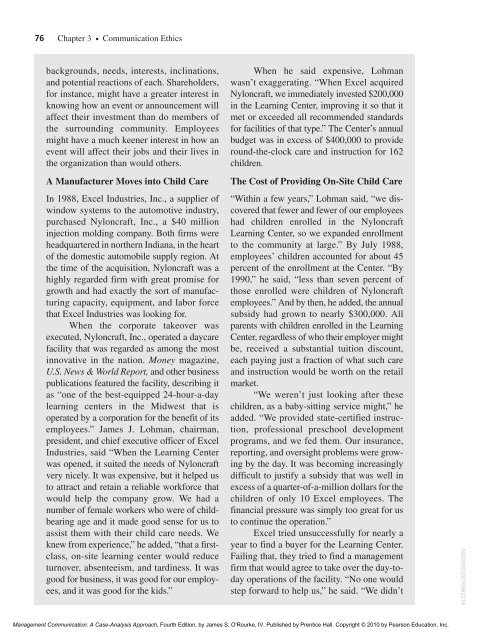MANAGEMENT COMMUNICATION - Pearson Learning Solutions
MANAGEMENT COMMUNICATION - Pearson Learning Solutions
MANAGEMENT COMMUNICATION - Pearson Learning Solutions
You also want an ePaper? Increase the reach of your titles
YUMPU automatically turns print PDFs into web optimized ePapers that Google loves.
76 Chapter 3 ● Communication Ethicsbackgrounds, needs, interests, inclinations,and potential reactions of each. Shareholders,for instance, might have a greater interest inknowing how an event or announcement willaffect their investment than do members ofthe surrounding community. Employeesmight have a much keener interest in how anevent will affect their jobs and their lives inthe organization than would others.A Manufacturer Moves into Child CareIn 1988, Excel Industries, Inc., a supplier ofwindow systems to the automotive industry,purchased Nyloncraft, Inc., a $40 millioninjection molding company. Both firms wereheadquartered in northern Indiana, in the heartof the domestic automobile supply region. Atthe time of the acquisition, Nyloncraft was ahighly regarded firm with great promise forgrowth and had exactly the sort of manufacturingcapacity, equipment, and labor forcethat Excel Industries was looking for.When the corporate takeover wasexecuted, Nyloncraft, Inc., operated a daycarefacility that was regarded as among the mostinnovative in the nation. Money magazine,U.S. News & World Report, and other businesspublications featured the facility, describing itas “one of the best-equipped 24-hour-a-daylearning centers in the Midwest that isoperated by a corporation for the benefit of itsemployees.” James J. Lohman, chairman,president, and chief executive officer of ExcelIndustries, said “When the <strong>Learning</strong> Centerwas opened, it suited the needs of Nyloncraftvery nicely. It was expensive, but it helped usto attract and retain a reliable workforce thatwould help the company grow. We had anumber of female workers who were of childbearingage and it made good sense for us toassist them with their child care needs. Weknew from experience,” he added, “that a firstclass,on-site learning center would reduceturnover, absenteeism, and tardiness. It wasgood for business, it was good for our employees,and it was good for the kids.”When he said expensive, Lohmanwasn’t exaggerating. “When Excel acquiredNyloncraft, we immediately invested $200,000in the <strong>Learning</strong> Center, improving it so that itmet or exceeded all recommended standardsfor facilities of that type.” The Center’s annualbudget was in excess of $400,000 to provideround-the-clock care and instruction for 162children.The Cost of Providing On-Site Child Care“Within a few years,” Lohman said, “we discoveredthat fewer and fewer of our employeeshad children enrolled in the Nyloncraft<strong>Learning</strong> Center, so we expanded enrollmentto the community at large.” By July 1988,employees’ children accounted for about 45percent of the enrollment at the Center. “By1990,” he said, “less than seven percent ofthose enrolled were children of Nyloncraftemployees.” And by then, he added, the annualsubsidy had grown to nearly $300,000. Allparents with children enrolled in the <strong>Learning</strong>Center, regardless of who their employer mightbe, received a substantial tuition discount,each paying just a fraction of what such careand instruction would be worth on the retailmarket.“We weren’t just looking after thesechildren, as a baby-sitting service might,” headded. “We provided state-certified instruction,professional preschool developmentprograms, and we fed them. Our insurance,reporting, and oversight problems were growingby the day. It was becoming increasinglydifficult to justify a subsidy that was well inexcess of a quarter-of-a-million dollars for thechildren of only 10 Excel employees. Thefinancial pressure was simply too great for usto continue the operation.”Excel tried unsuccessfully for nearly ayear to find a buyer for the <strong>Learning</strong> Center.Failing that, they tried to find a managementfirm that would agree to take over the day-todayoperations of the facility. “No one wouldstep forward to help us,” he said. “We didn’t000200010270582216Management Communication: A Case-Analysis Approach, Fourth Edition, by James S. O'Rourke, IV. Published by Prentice Hall. Copyright © 2010 by <strong>Pearson</strong> Education, Inc.

















